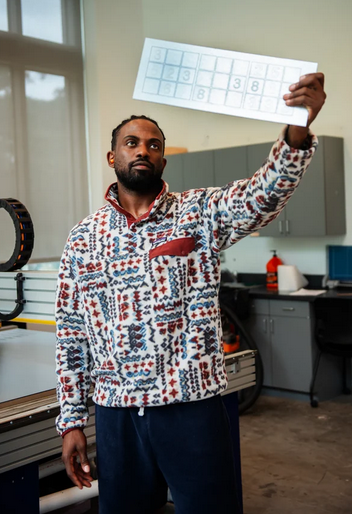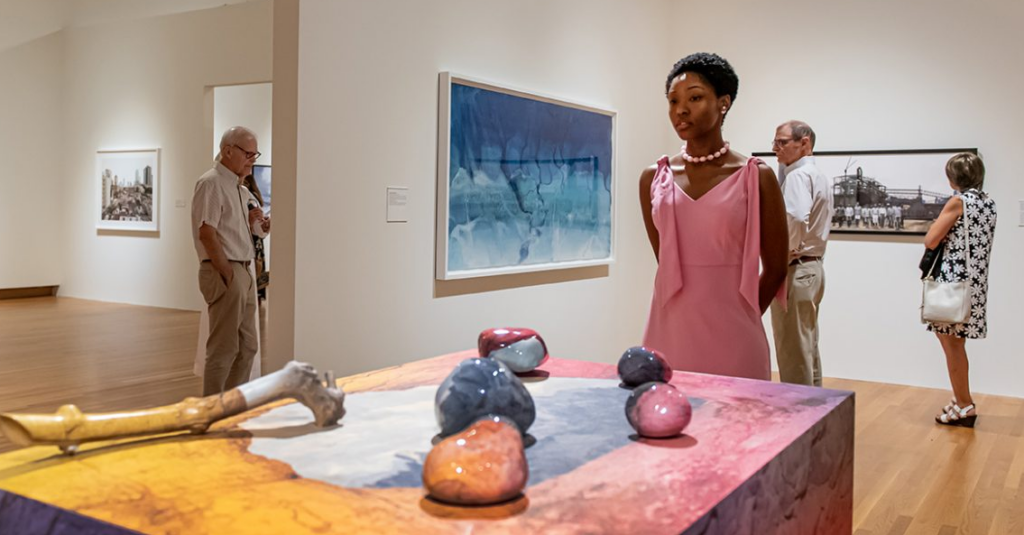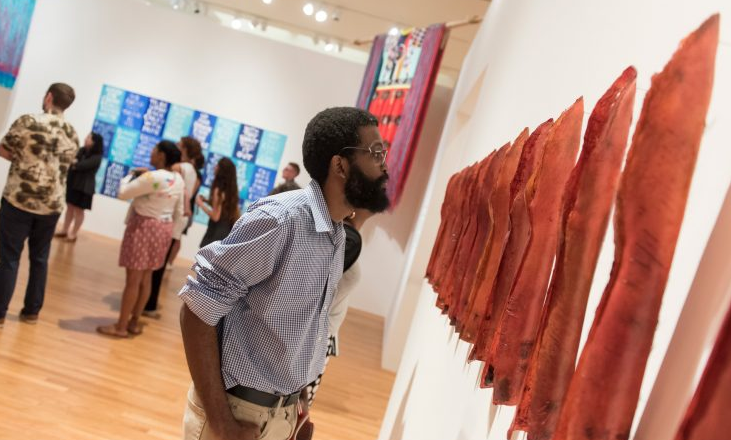Photos: J. Caldwell /Nasher Museum\YouTube
DURHAM, NC – This September, the Nasher Museum of Art at Duke University will premiere Processing Systems: Numbers by Sherrill Roland, featuringnew works of art and research materials by artist Sherrill Roland (b. 1984, Asheville, NC) from his ongoing exploration of the criminal justice system and inspired by the cases of people wrongfully convicted in North Carolina. Roland’s interdisciplinary practice deals with concepts of innocence, identity, and community, reimagining their social and political implications in the context of the American criminal justice system. Processing Systems will be on view at the Nasher Museum from September 19, 2024 – January 12, 2025.

For more than three years, Roland’s right to self-determination was lost to wrongful incarceration. After spending ten months in prison for a crime for which he was later exonerated, he returned to his artistic practice that he now uses as a vehicle for self-reflection and an outlet for emotional release. Converting the haunting nuances of his experiences into drawings, sculptures, multimedia objects, performances, and participatory activities, Roland shares his story and creates space for others to do the same, illuminating the invisible costs, damages, and burdens of incarceration.
“Sherrill Roland’s large-scale works are a powerful commentary on the lasting impact of our criminal justice system,” said Trevor Schoonmaker, Mary D.B.T. and James H. Semans Director of the Nasher Museum. “This exhibition is also a testament to the cross-disciplinary nature of Roland’s practice, and his willingness to continue to experiment with new forms and ideas, pushing himself to work in new mediums. We know that Roland’s personal journey and his commitment to exploring the longstanding effects of wrongful incarceration through his art will resonate with Museum visitors and create a space for dialogue about an underexamined facet of our society.”
Processing Systems is part of a cross-disciplinary project that critically examines United States Federal and State Correctional Identification Numbers, which are assigned to inmates upon incarceration and historically have been used to reduce individuals to a series of digits. Refuting the dehumanizing and anonymizing aspects of this system, Roland uses these digits to generate number-based artworks that follow specific rules, like sudoku puzzles, which helped him pass the time while he was wrongfully incarcerated before he was exonerated in 2015.
“In this new body of work, Roland makes his first foray into portraiture with these conceptual depictions of wrongfully incarcerated individuals in North Carolina,” said Julia McHugh, Trent A. Carmichael Director of Academic Initiatives and Curator of Arts of the Americas at the Nasher Museum and the exhibition’s co-curator. “Drawing inspiration from works in our collection and from the true stories of other wrongfully convicted individuals through conversations at Duke’s Wilson Center for Science and Justice, Roland crafts compelling ‘portraits’ of these individuals through the correctional identification numbers that, in the eyes of the state, defined their existence when they were incarcerated but cannot encapsulate their humanity.”

Processing Systems includes a set of new large-scale numerical portraits, engraved in aluminum, and created by combining the Correctional Identification Numbers of individuals who have been exonerated in North Carolina in recent decades. In these artworks, Roland uses this logic game as an art-making tool, a vehicle to illustrate criminal identification numbers. A criminal ID is made up of two parts. The first part consists of five digits that are associated with the sequential order of conviction in one’s county. The second part presents three digits that are related to the state in which one is convicted. Scrambled and reorganized through the complex structure of sudoku puzzles, these abstract portraits by Roland honor individuals who have been exonerated in North Carolina in recent decades, without exposing their image or personal information. The titles of individual works include the number of days that each person was wrongfully imprisoned.
“Creating new art with a world-class artist like Sherrill, whose beautiful works always incorporate thorough research and highly relevant social concerns, is just the kind of thing a research university can do, and I am very grateful to the Mellon Foundation and all our campus collaborators for making it all possible,” said Pedro Lasch, Research Professor of Art, Art History and Visual Studies and Director of the Social Practice Lab at Duke and the exhibition’s co-curator.
The exhibition’s central vitrine revisits Roland’s 168.800 series of sculptures, which explore the oppressive facades of prisons through geometric variations based on the form of the cinder block. Using an advanced 3-D color printer for the first time in his artistic practice, Roland begins to reimagine the scale of his 168.800 series, which uses the form of the cinderblock to critique the oppressive facades and interiors of prisons. While previous iterations of this series use steel and Kool-Aid (materials that are interwoven into prison life), these latest works print small shapes in plastic. The traced shapes from the maquettes also reappear in three isometric drawings in the exhibition. They depict a specific element’s position within the walls and the architecture of a prison cell.
On view concurrently is a complementary installation curated by Roland featuring selections from the Nasher Museum’s permanent collection that depict prison architecture and the criminal justice system throughout history. Seeing from the Block: Observing the Justice System through the Collection of the Nasher Museum will be on view in the Trent A. Carmichael Academic Focus Gallery. Featuring works by artists including Charles Gaines, Ed Ruscha, and Leonard Freed, the subjects include inmates and police patrols, while others depict federal buildings, floorplans, and facades that hint more subtly at Roland’s interest in the architecture of incarceration. A related installation, Processing Systems: Bonding by Sherrill Roland, is also on view at the Ackland Art Museum at UNC-Chapel Hill until July 13, 2025.
Exhibition Organization and Support
Processing Systems is co-curated by Pedro Lasch, Research Professor of Art, Art History and Visual Studies and Director of the Social Practice Lab at Duke, and Julia McHugh, Trent A. Carmichael Director of Academic Initiatives and Curator of Arts of the Americas at the Nasher Museum.
Presented as the culmination of a two-year Mellon Foundation Artistic Research Initiative Fellowship at the Franklin Humanities Institute’s Social Practice Lab, the exhibition and its programming include collaborations and support from the Nasher Museum; the Office of Information Technology’s Colab & DesignHub; Duke’s Wilson Center for Science & Justice; the Department of Art, Art History & Visual Studies; Duke Arts; and the Rubenstein Arts Center at Duke. Processing Systems is made possible by Ruth (A.B.’81, P’11) and John Caccavale (A.B.’81, P’11).
Related Events
In conjunction with the exhibition, the Nasher Museum will present the following public programs:
- A public opening for the exhibition, including a conversation between Sherill Roland and Pedro Lasch, will be held Thursday, September 19, 6:00-8:00 p.m.
- A panel discussion, co-hosted by the Wilson Center for Science and Justice, on the wide-ranging impacts of the criminal legal system on individuals and communities. Students, attorneys, and advocates will be in conversation with artist Sherrill Roland on Thursday, October 10, 6:30-8:30 p.m.

About the Nasher Museum of Art at Duke University
The Nasher Museum of Art at Duke University is a major center for the arts in Durham, North Carolina, and the surrounding region. The 65,000-square-foot building was designed by architect Rafael Viñoly. Since opening in 2005, the museum has organized and presented leading-edge exhibitions that travel worldwide. From the beginning, the Nasher Museum has been dedicated to building a groundbreaking collection of contemporary art. In this effort, the museum’s collection strategy emphasizes works by diverse artists who have been historically underrepresented. Learn more at nasher.duke.edu.






